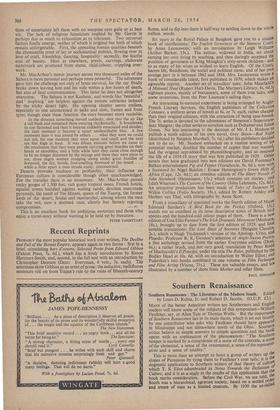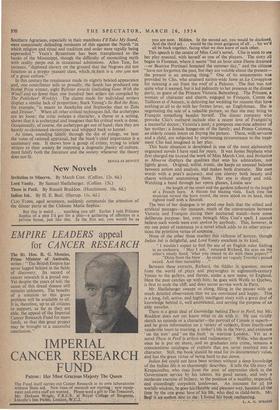Southern Renaissance
MANY of the better American writers are Southerners and English readers will know some of the subjects of this symposium—Williaol Faulkner, say, or Allen Tate or Thomas Wolfe. But the importance of Southern Renascence lies in its main thesis, which is set out bluntly by one contributor who asks why Faulkner should have appeared In Mississippi and not somewhere north of the Ohio. Souther critics believe in simple answers to simple questions and the boa opens with an explanation of the phenomenon: "The Southen) temper is marked by a coincidence of a sense of the concrete, a sense of the elemental, a sense of the ornamental, a sense of the represent' ative and a sense of totality." This is more than an attempt to hoist a group of writers up the slopes of Parnassus by tying them to Faulkner's coat tails; it is the dogmatic application to Southern writers of that theory of culture, which T. S. Eliot adumbrated in Notes Towards the Definition 0/ Culture, and it is as a study in the results of this application that the book merits consideration. Before the Civil War, we are told, the South was a hierarchical, agrarian society, based on a settled order, and aware of man as a limited creature. By 1930 the sb-ca Southern Agrarians, especially in their manifesto I'll Take My Stand, were consciously defending remnants of this against the North "in which religion and ritual and tradition and order were rapidly being superseded." Yeats's Byzantium has been transplanted to the banks of the Mississippi, though the difficulty of reconciling myth with reality peeps out in occasional admissions. Allen Tate, for instance, "deplored slavery on the ground that the Negroes did not function as a proper peasant class, which in turn is a sine qua non of a great culture." century In this ntury the renaissance made its slightly belated appearance and, one contributor tells us proudly, the South has produced one I, Nobel Prize winner, eight Pulitzer awards (including Gone With the . Wald) and no fewer than one hundred best sellers (as compiled by The Publishers' Weekly). The claims made for individual writers I display a similar lack of proportion; Stark Young's So Red the Rose, 1; for example, "is nearer to Aeschylus and Sophocles than to Zola I and Dreiser." When all other critical techniques fail, the archetypes are let loose; the critic isolates a character, a theme or a setting, shows that it is archetypal and imagines that his critical work is done.
$ Occasionally, of course, the archetypes get out of hand; then they are hastily re-christened stereotypes and whipped back to kennel. At times, sounding faintly through the din of eulogy, we hear the voice of rational appraisal, but the book's chief importance is a ry cautionary one. It shows how a group of critics, trying to relate 4, writers to their society by imposing a dogmatic ,theory of culture, must falsify both the literature and the society whenever the theory does not fit.
DOUGLAS HEWITT











































 Previous page
Previous page